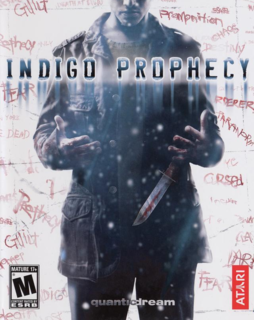Indigo Prophecy is a very enjoyable game that shows that the adventure genre isn't dead.
The game starts out with you, Lucas Kane, sitting in a bathroom stall. You’ve cut your arms, you’re twitching, and you’re holding a knife. As a man goes to wash his hands you get up. You begin stumbling towards him in a trance. Then you raise your blade. And stab him. He falls to the ground, shocked, paralyzed. You then stab him again, and again. You suddenly come out your trance. You’re shocked to see that you’ve done. Now it’s up to you to decide what you’re going to do. This is the basis of Indigo Prophecy. You have to figure why you murdered that man. The second best thing in Indigo Prophecy is the voice acting. It’s near Hollywood quality. The actors all did amazing jobs and really draw you into the story.
Over the past years the point and click adventure style has become far less popular, and for good reason. They often have you find various trinkets and
try to figure out what they do and these games can often become boring, thankfully Indigo Prophecy is able to keep the player involved through several game play methods. Like some recent adventure games Indigo Prophecy has direct control. This means that you directly control the character on screen, instead of clicking where you want them to go. Another cool feature that I hadn’t seen in previous adventure games is the “Simon Say’s” action sequences. Instead of throwing in some lame combat system, or trying to make some sort of action game, Quantic Dream put a system in where you have to move the joysticks as it tells you. Two circles with four sections each will come up on screen, and depending on what section lights up you have to move the joysticks in that direction. This allows cool cut scenes to be played, which would be impossible with a combat system. This isn’t only used for combat but as well as conversations and chase sequences. It works surprisingly well and I hope to see it in more games. Another method the game uses is a button mashing mini game where you press the left and right triggers as fast as you can. This is often used while running. What also keeps the game is interesting is that you not only play as Lucas, but also as the two cops trying to find Lucas. This adds an interesting twist to the game as you can throw off the cops, or aid them.
Another strong element of Indigo Prophecy is how cinematic the game is. It’s able to do this through two main things. The first and foremost is the camera angles it uses. It shot much like a movie is shot and often splits the screen up to create effects, such as a police man coming down the hallway while you control your character on the other screen. The other part that helps to keep the cinematic quality of the game is in part because of the “Simon Say’s” sequences. This allows the game to keep the camera angles and keep the cinematic quality.
This isn’t to say that Indigo Prophecy isn’t without its problems. Although I try not to judge a game by its graphics, Indigo Prophecy’s graphics are pretty bad, and I really think it would have helped improve the character’s emotion if the graphics would have been better as you could better see their expressions. Also found the end to be rushed. All of the major plot points are wrapped up in less than a half-hour and the ending just kind of leaves you hanging and felt it could have elaborated on what happened at the end of the game. There was also a problem I found with some of the button mashing mini games would mess up and no matter how well I did I would fail, but the next time it would work flawlessly.
Despite its flaws Indigo Prophecy is a good game. I think that if you give it a chance you’ll soon find that you’ll be so caught up in the story that you won’t really notice the flaws with the game. Overall though Indigo Prophecy is a very enjoyable game and I highly recommend it.

